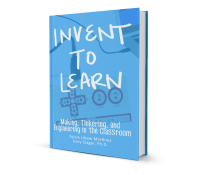Bright.com (the education section of Medium.com) has published an article called Putting Away the Books to Learn by Jackie Ashton.
It starts with the question: “The “maker” movement has swept across schools in California and beyond. Can it fundamentally change K-12 education?”
The article profiles several schools involved in “making” and quotes some folks, including me, about how “making” has the potential to change education. Most of my interview ended up on the cutting room floor, unfortunately. But that’s the way the media cookie crumbles, as they say!
It’s an interesting take on “making” and the article struggles a bit, I think, to situate it in a learning context. Not that I’m surprised or criticizing. It’s the heart of the difficulty of advocating for “maker education” – the examples start to sound like you are cheerleading for any techy type thing that kids put their hands on, whether it’s thoughtful, challenging, academic or not.
Even the title “Putting Away the Books to Learn” is a misinterpretation of the kind of classroom experience I advocate for. In a maker-enabled learning space, books and reference materials (both online and physical) should be one of the most important tools available to students.
For example, at our summer institute, Constructing Modern Knowledge, we bring cases of books to build a library for participants. We believe that this highly-curated library is one of the most important aspects of creating a model maker learning experience. Books can inspire and inform, or sometimes just provide a coffee-break for a tired brain.
Maker education is not an either/or choice between old-fashioned and new-fangled stuff. It’s grounded (hopefully) in ideas about the ways learning really happens inside the learner’s head. Beyond that, there are definitely some technologies that can enhance the quest to teach students about the real world, but to me, the “stuff” should take a backseat to the learning.
- Can you do “maker” without a 3D printer? Yes
- Can you do things with a 3D printer that give students access to ideas otherwise nearly impossible? Yes
Both of these can be true, and that may seem confusing. But I think the possibilities inherent in all these seemingly contradictory paths are worth exploring. There is no one model of maker education that is going to work for every learning space and every learner. That should be seen as freedom to be nurtured, not a deficiency.


 I keynoted the
I keynoted the